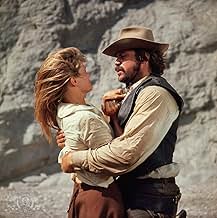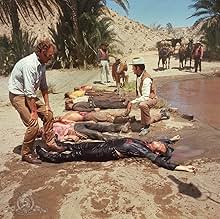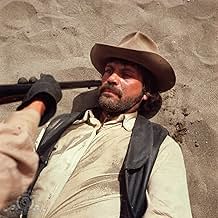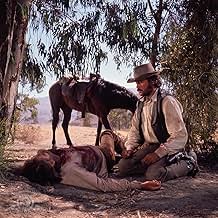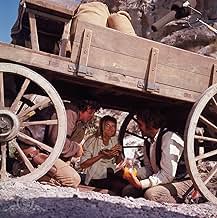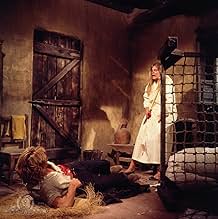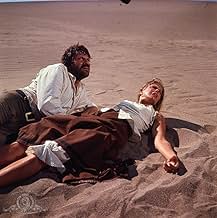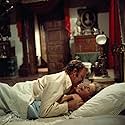IMDb RATING
6.2/10
3.6K
YOUR RATING
A cattle baron with a long-range rifle hunts the outlaw who kidnapped his wife.A cattle baron with a long-range rifle hunts the outlaw who kidnapped his wife.A cattle baron with a long-range rifle hunts the outlaw who kidnapped his wife.
Francesca Tu
- Chinese Girl
- (as Francisca Tu)
Ralph Brown
- Sheriff
- (as Ralph Browne)
Charly Bravo
- Cowboy
- (as Carlos Bravo)
Storyline
Did you know
- TriviaThis is the second Western in as many years for Candice Bergen which has a reputation for extreme brutality. The other was Soldier Blue (1970) released the year before.
- GoofsNone of the hunting party's horses are packing the rifles when they get off the train. Even the two pack horses have packs too small to hold rifles (or much else for that matter).
- Quotes
Frank Calder: You ain't too bad. For a schoolteacher.
Melissa Ruger: If you think you're going to get a lot of money for me, you're wrong. They'll be coming after us, you know. A lot of men.
Frank Calder: Why? They short of teachers back there?
Melissa Ruger: I am not a teacher. I am Brandt Ruger's wife. I am! I am Brandt Rugers wife!
Frank Calder: It don't matter whose wife you are. There ain't nothin' he can do about it.
Melissa Ruger: Why do you want to learn to read?
Frank Calder: 'Cause I can't.
- Alternate versionsThe British network version aired on BBC2 in 1999 had several cuts, including a close-up of a cow being slaughtered during the opening sequence, the ending of the scene with Brandt Ruger and the chinese prostitute (he forces her into the bed and tortures her with his cigar), the death of one of Ruger's friends and some horsefalls when Frank Calder ambushes the hunting party and some shots of Hog Warren beating Melissa during the attempted rape.
- ConnectionsFeatured in The Honkers (1972)
Featured review
When you go hunting with Brandt Ruger, you go first-class all the way. But when you steal his "property", you sign your own death warrant.
That is something that a notorious outlaw (Oliver Reed) and his gang have to learn in the worst way possible in THE HUNTING PARTY, a 1971 British/American western that, even by 21st century standards, is still incredibly violent. Reed kidnaps a local schoolteacher (Candice Bergen) in the (now faint) hope that he'll be taught how to read. When Bergen warns him about her husband, he tells her "It don't matter whose wife you are." A fatal misjudgment on his part, for her husband Brandt Ruger (Gene Hackman) is not one to fool around with. While out on a hunting party with a few of his friends, the dictatorial and very abusive land baron learns of Bergen's kidnapping, and thus gets blood in his eyes. And rather than going after game, he and his boys instead go after Reed and his gang, picking them off one at a time with high-power rifles that can hit from a distance of 800 yards. The result is a sagebrush variation of THE MOST DANGEROUS GAME, done with some of the most brutally violent shootouts this side of THE WILD BUNCH and SOLDIER BLUE. And as he is a man driven by extreme jealousy (Bergen is his personal "property", whom he physically abuses on more than one occasion), the fact that Bergen is beginning to develop a rapport with Reed now gives him whatever license he feels he needs to kill her as well, though he drags it out for the sheer sadistic fun of it to a very cynical and blood-splattered conclusion.
There isn't too much doubt that THE HUNTING PARTY was made to take advantage of the "market" opened up by THE WILD BUNCH and its director Sam Peckinpah's choreography of violent action, as well the spaghetti westerns of Sergio Leone. The shootouts are extremely bloody, and they clearly mirror those of THE WILD BUNCH in the use of slow motion and quick cutting. Where THE HUNTING PARTY falls short, however, is in a crucial area that Peckinpah knew was vital to his film being successful: the action and plot must be character-driven and made to feel real to an audience. Veteran TV director Don Medford (who, among other things, directed the classic 1961 Twilight Zone episode "Death's Head Revisited) and screenwriters Gilbert Ralston, William Norton, and Lou Morheim know how to do the Peckinpah-inspired gunfights, but they don't seem to have taken too much time to really delineate any complexities in the three main characters. Bergen is merely a damsel in distress, caught between two men who are basically bastards, one merely semi-controlling (Reed), the other a sadistic control freak of the highest order (Hackman). Absent the complex psychological and character-driven narrative that propelled THE WILD BUNCH to a controversial but well-deserved glory, THE HUNTING PARTY can so easily be tagged, as more than a few critics have done (albeit perhaps too zealously), as an extremely bloody sagebrush shooting gallery in which violence is staged for the sake of violence.
The film does succeed in giving us good performances from the three leads (notably Hackman, whose role is credibly sadistic to the highest degree); good cinematography done on location in Spain (as a stand-in for Texas); and supporting roles for L.Q. Jones (a member of Peckinpah's stock company); Simon Oakland; Mitchell Ryan; and William C. Watson. And one can't fault the long-distance shooting that occurs, or the way it so ingeniously borrows a great old-world story (THE MOST DANGEROUS GAME) and puts it into a WILD BUNCH-type western format. Had the filmmakers only paid a bit more attention to complex characters and motives here as Peckinpah had in his epic film, however, THE HUNTING PARTY might have been a bit more than a good, if incredibly and graphically violent, post-Peckinpah/Leone addition to a Western genre that was rapidly changing during the late 1960s and early 1970s.
That is something that a notorious outlaw (Oliver Reed) and his gang have to learn in the worst way possible in THE HUNTING PARTY, a 1971 British/American western that, even by 21st century standards, is still incredibly violent. Reed kidnaps a local schoolteacher (Candice Bergen) in the (now faint) hope that he'll be taught how to read. When Bergen warns him about her husband, he tells her "It don't matter whose wife you are." A fatal misjudgment on his part, for her husband Brandt Ruger (Gene Hackman) is not one to fool around with. While out on a hunting party with a few of his friends, the dictatorial and very abusive land baron learns of Bergen's kidnapping, and thus gets blood in his eyes. And rather than going after game, he and his boys instead go after Reed and his gang, picking them off one at a time with high-power rifles that can hit from a distance of 800 yards. The result is a sagebrush variation of THE MOST DANGEROUS GAME, done with some of the most brutally violent shootouts this side of THE WILD BUNCH and SOLDIER BLUE. And as he is a man driven by extreme jealousy (Bergen is his personal "property", whom he physically abuses on more than one occasion), the fact that Bergen is beginning to develop a rapport with Reed now gives him whatever license he feels he needs to kill her as well, though he drags it out for the sheer sadistic fun of it to a very cynical and blood-splattered conclusion.
There isn't too much doubt that THE HUNTING PARTY was made to take advantage of the "market" opened up by THE WILD BUNCH and its director Sam Peckinpah's choreography of violent action, as well the spaghetti westerns of Sergio Leone. The shootouts are extremely bloody, and they clearly mirror those of THE WILD BUNCH in the use of slow motion and quick cutting. Where THE HUNTING PARTY falls short, however, is in a crucial area that Peckinpah knew was vital to his film being successful: the action and plot must be character-driven and made to feel real to an audience. Veteran TV director Don Medford (who, among other things, directed the classic 1961 Twilight Zone episode "Death's Head Revisited) and screenwriters Gilbert Ralston, William Norton, and Lou Morheim know how to do the Peckinpah-inspired gunfights, but they don't seem to have taken too much time to really delineate any complexities in the three main characters. Bergen is merely a damsel in distress, caught between two men who are basically bastards, one merely semi-controlling (Reed), the other a sadistic control freak of the highest order (Hackman). Absent the complex psychological and character-driven narrative that propelled THE WILD BUNCH to a controversial but well-deserved glory, THE HUNTING PARTY can so easily be tagged, as more than a few critics have done (albeit perhaps too zealously), as an extremely bloody sagebrush shooting gallery in which violence is staged for the sake of violence.
The film does succeed in giving us good performances from the three leads (notably Hackman, whose role is credibly sadistic to the highest degree); good cinematography done on location in Spain (as a stand-in for Texas); and supporting roles for L.Q. Jones (a member of Peckinpah's stock company); Simon Oakland; Mitchell Ryan; and William C. Watson. And one can't fault the long-distance shooting that occurs, or the way it so ingeniously borrows a great old-world story (THE MOST DANGEROUS GAME) and puts it into a WILD BUNCH-type western format. Had the filmmakers only paid a bit more attention to complex characters and motives here as Peckinpah had in his epic film, however, THE HUNTING PARTY might have been a bit more than a good, if incredibly and graphically violent, post-Peckinpah/Leone addition to a Western genre that was rapidly changing during the late 1960s and early 1970s.
- How long is The Hunting Party?Powered by Alexa
Details
Box office
- Budget
- $1,600,000 (estimated)
- Runtime1 hour 51 minutes
- Color
- Aspect ratio
- 1.85 : 1
Contribute to this page
Suggest an edit or add missing content



